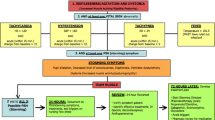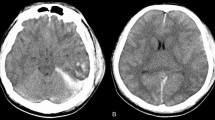Abstract
Introduction
A 38-year-old man with severe head trauma complicated by paroxysmal severe intracranial pressure elevation associated with tachypnea, tachycardia, diaphoresis, and extensor posturing was diagnosed as suffering from paroxysmal autonomic instability with dystonia (PAID). These events were unresponsive to standard medical therapy, which included morphine, fentanyl, labetalol, lorazepam, metoprolol, and clonidine.
Methods
A trial treatment with dexmedetomidine, a central acting alpha2-agonist, to control symptoms of PAID was initiated 12 days after injury. PAID-related events subsided during the 72-h infusion protocol of 0.2–0.7 mcg/kg/h. No further events were noted after termination of the 72-h infusion.
Conclusions
Dexmedetomidine may be a novel pharmacologic agent to aid in abrogating PAID.

Similar content being viewed by others
References
Blackman JA, Patrick PD, Buck ML, Rust RS Jr. Paroxysmal autonomic instability with dystonia after brain injury. Arch Neurol 2004;61(3):321–8.
Fernandez-Ortega JF, Prieto-Palomino MA, Munoz-Lopez A, Lebron-Gallardo M, Cabrera-Ortiz H, Quesada-Garcia G. Prognostic influence and computed tomography findings in dysautonomic crises after traumatic brain injury. J Trauma 2006;61(5):1129–33.
Goh KY, Conway EJ, DaRosso RC, Muszynski CA, Epstein FJ. Sympathetic storms in a child with a midbrain glioma: a variant of diencephalic seizures. Pediatr Neurol 1999;21(4):742–4.
Talman WT, Florek G, Bullard DE. A hyperthermic syndrome in two subjects with acute hydrocephalus. Arch Neurol 1988;45(9):1037–40.
Boeve BF, Wijdicks EF, Benarroch EE, Schmidt KD. Paroxysmal sympathetic storms (“diencephalic seizures”) after severe diffuse axonal head injury. Mayo Clin Proc 1998;73(2):148–52.
Baguley IJ, Heriseanu RE, Felmingham KL, Cameron ID. Dysautonomia and heart rate variability following severe traumatic brain injury. Brain Inj 2006;20(4):437–44.
Eltorai IM, Wong DH, Lacerna M, Comarr AE, Montroy R. Surgical aspects of autonomic dysreflexia. J Spinal Cord Med 1997;20(3):361–4.
Keren O, Yupatov S, Radai MM et al. Heart rate variability (HRV) of patients with traumatic brain injury (TBI) during the post-insult sub-acute period. Brain Inj 2005;19(8):605–11.
Bernath O. Treatment of paroxysmal sympathetic storm with labetalol. J Neurol Neurosurg Psychiatry 2001;70(6):818–9.
Diamond AL, Callison RC, Shokri J, Cruz-Flores S, Kinsella LJ. Paroxysmal sympathetic storm. Neurocrit Care 2005;2(3):288–91.
Do D, Sheen VL, Bromfield E. Treatment of paroxysmal sympathetic storm with labetalol. J Neurol Neurosurg Psychiatry 2000;69(6):832–3.
Bullard DE. Diencephalic seizures: responsiveness to bromocriptine and morphine. Ann Neurol 1987;21(6):609–11.
Becker R, Benes L, Sure U, Hellwig D, Bertalanffy H. Intrathecal baclofen alleviates autonomic dysfunction in severe brain injury. J Clin Neurosci 2000;7(4):316–9.
Cuny E, Richer E, Castel JP. Dysautonomia syndrome in the acute recovery phase after traumatic brain injury: relief with intrathecal Baclofen therapy. Brain Inj 2001;15(10):917–25.
Hogue CW Jr., Talke P, Stein PK, Richardson C, Domitrovich PP, Sessler DI. Autonomic nervous system responses during sedative infusions of dexmedetomidine. Anesthesiology 2002;97(3):592–8.
Feld J, Hoffman WE, Paisansathan C, Park H, Ananda RC. Autonomic activity during dexmedetomidine or fentanyl infusion with desflurane anesthesia. J Clin Anesth 2007;19(1):30–6.
Gurbet A, Basagan-Mogol E, Turker G, Ugun F, Kaya FN, Ozcan B. Intraoperative infusion of dexmedetomidine reduces perioperative analgesic requirements. Can J Anaesth 2006;53(7):646–52.
Bicer C, Esmaoglu A, Akin A, Boyaci A. Dexmedetomidine and meperidine prevent postanaesthetic shivering. Eur J Anaesthesiol 2006;23(2):149–53.
Oppenheimer SM, Gelb A, Girvin JP, Hachinski VC. Cardiovascular effects of human insular cortex stimulation. Neurology 1992;42(9):1727–32.
Oppenheimer SM, Kedem G, Martin WM. Left-insular cortex lesions perturb cardiac autonomic tone in humans. Clin Auton Res 1996;6(3):131–40.
Swissa M, Zhou S, Gonzalez-Gomez I et al. Long-term subthreshold electrical stimulation of the left stellate ganglion and a canine model of sudden cardiac death. J Am Coll Cardiol 2004;43(5):858–64.
Watt JA, Moffet CW, Zhou X, Short S, Herman JP, Paden CM. Central peptidergic neurons are hyperactive during collateral sprouting and inhibition of activity suppresses sprouting. J Neurosci 1999;19(5):1586–98.
Zhou S, Cao JM, Swissa M et al. Low-affinity nerve growth factor receptor p75NTR immunoreactivity in the myocardium with sympathetic hyperinnervation. J Cardiovasc Electrophysiol 2004;15(4):430–7.
Author information
Authors and Affiliations
Corresponding author
Rights and permissions
About this article
Cite this article
Goddeau, R.P., Silverman, S.B. & Sims, J.R. Dexmedetomidine for the treatment of paroxysmal autonomic instability with dystonia. Neurocrit Care 7, 217–220 (2007). https://doi.org/10.1007/s12028-007-0066-0
Published:
Issue Date:
DOI: https://doi.org/10.1007/s12028-007-0066-0




